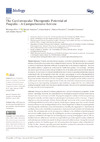Identificador persistente para citar o vincular este elemento:
https://accedacris.ulpgc.es/jspui/handle/10553/77343
| Título: | The cardiovascular therapeutic potential of propolis—a comprehensive review | Autores/as: | Silva, Henrique Francisco, Rafaela De Figueiredo Saraiva, Ariana Maria Francisco, Simone Carrascosa Iruzubieta, Conrado Javier Raposo, António |
Clasificación UNESCO: | 320501 Cardiología 3206 Ciencias de la nutrición 320607 Elementos minerales en la alimentación |
Palabras clave: | Antiangiogenic Antihypertensive Antioxidant Cardiovascular Protection Propolis |
Fecha de publicación: | 2021 | Publicación seriada: | Biology | Resumen: | Owing to its chemical richness, propolis has a myriad of therapeutic properties. To the authors’ knowledge, this is the first comprehensive review paper on propolis to focus exclusively on its major effects for cardiovascular health. The propolis compound varieties with the most promising therapeutic benefits and their respective physiological mechanisms will be discussed. Propolis displays an anti-atherosclerotic activity, attained through modulation of the plasma lipid profile and through stabilization of the fatty plaque by inhibiting macrophage apoptosis, vascular smooth muscle proliferation and metalloproteinase activity. The antihypertensive effects of propolis probably arise through the combination of several mechanisms, including the suppression of catecholamine synthesis, stimulation of endothelium-dependent vasorelaxation and vascular anti-inflammatory activity. The anti-hemostatic activity of propolis is attributed to the inhibition of platelet plug formation and antifibrinolytic activity. By inhibiting the secretion of proangiogenic factors, propolis suppresses endothelial cell migration and tubulogenesis, exerting antiangiogenic activity. The an-tioxidant and anti-inflammatory activities are responsible for protection against vascular endothelial and cardiomyocyte dysfunction, mostly by the prevention of oxidative stress. Among the reviewed propolis varieties, the Brazilian green and red varieties show the largest number of beneficial ac-tivities. Further research, especially preclinical, should be conducted to assess the cardiovascular benefits of the given varieties with different compositions. | URI: | https://accedacris.ulpgc.es/handle/10553/77343 | ISSN: | 2079-7737 | DOI: | 10.3390/biology10010027 | Fuente: | Biology [EISSN 2079-7737], v. 10 (1), 27, (Enero 2021) |
| Colección: | Artículos |
Citas SCOPUSTM
37
actualizado el 08-jun-2025
Citas de WEB OF SCIENCETM
Citations
29
actualizado el 08-jun-2025
Visitas
221
actualizado el 01-nov-2024
Descargas
85
actualizado el 01-nov-2024
Google ScholarTM
Verifica
Altmetric
Comparte
Exporta metadatos
Los elementos en ULPGC accedaCRIS están protegidos por derechos de autor con todos los derechos reservados, a menos que se indique lo contrario.
